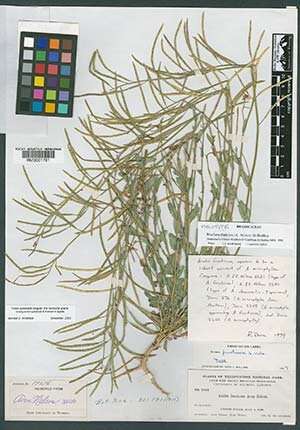Study shows plant extinction is more common than previously realized
by Science X staff
A University of Wyoming researcher contributed to a paper that revealed extinction of plants in North America is more common than previously known.
The new study reveals that 65 plant species—including the Yellowstone rockcress or Boechera fructicosa in Wyoming—have apparently gone extinct in the continental United States and Canada since European settlement.
"This paper reflects the lifetimes of work by biologists across the country going back to the time of Aven Nelson and has, as its foundation, a host of initiatives over the past 50-plus years," says Bonnie Heidel, lead botanist of UW's Wyoming Natural Diversity Database.
Heidel is co-author of a paper, titled "Vascular Plant Extinction in the Continental United States and Canada," that appeared in the Aug. 28 issue of Conservation Biology. The journal publishes groundbreaking papers and is instrumental in defining the key issues contributing to the science and practice of conserving Earth's biological diversity.
Nelson was an American botanist who specialized in plants of the Rocky Mountains. He was one of the founding professors of UW, where he taught for 55 years and served as president (1917-1922). The Aven Nelson Building near UW's Old Main is named after him.
"Preventing extinction is the lowest bar for conservation success we can set, yet we are not always successful," says Wesley Knapp, the paper's lead author and botanist with the North Carolina Natural Heritage Program. "This study started as an academic question, but later developed into an opportunity to learn from what we have lost. By studying the trends and patterns of plants that have already gone extinct, hopefully we can learn how to prevent plant extinction going forward."
Botanists who contributed to the paper were from state and federal agencies, herbaria, academic institutions, botanical gardens and organizations across the country. They are NatureServe in Arlington, Va.; Florida Institute for Conservation Science; New York Botanical Garden; University of North Carolina; The Institute for Regional Conservation in Delray Beach, Fla.; University of California; Missouri Botanical Garden; U.S. Department of Agriculture; University of Washington; Texas Parks and Wildlife Department; U.S. Forest Service in Albuquerque, N.M.; and the California Native Plant Society.
The research group found that most plant extinctions occurred in the western United States, where the vegetation was minimally explored before widespread European settlement. Because many extinctions likely occurred before scientists explored an area, it is likely the 65 documented extinctions vastly underestimate the actual number of plant species that have been lost, according to the paper. The one previous study that addressed worldwide plant extinctions documented far fewer plant extinctions on the North American continent.
The one species that made the list from Wyoming is Yellowstone rockcress. Nelson collected it in 1899 from Yellowstone National Park. It has not been seen since, becoming the subject of a botanical detective story that might have ended in extinction. Experts across the country, from New York and North Carolina to Utah, are still trying new leads. Heidel says there have been three main rounds of searches—the 1930s, 1970s and in recent years—to locate the Yellowstone rockcress.
"The first two searches were unsuccessful, and the current work has not relocated the species to date, but has the genetic results that may help them pin down their target," she says.
Of the 65 documented extinctions in the report, 64 percent were known only from a single location, such as Yellowstone rockcress. While conservation often focuses on protecting entire landscapes, this finding points to the importance of small-scale site protection and attention in order to prevent extinctions. This work also highlights the need for collaborative science in addressing large-scale conservation issues.
This work, as a benchmark of plant species loss—or potential loss—underscores the success and expanded knowledge in maintaining the current flora. In the past, there were about 100 vascular plants in Wyoming considered for protection under the Endangered Species Act that have not required intervention, Heidel says.
"We are fortunate that most of the state flora is secure," she says.
Wyoming has many species in the rockcress genus, which is under investigation by a nationwide team as a window into understanding plant diversity and taxonomic relationships, Heidel notes.
"It is in a family called the mustard family, having many of the top 100 food crops in the world," she says. "Whether Yellowstone rockcress is extinct or not, this article is a reminder that certain species of plants face imperilment, whether we know the cause or not."
More information: Wesley M. Knapp et al. Vascular plant extinction in the continental United States and Canada, Conservation Biology (2020). DOI: 10.1111/cobi.13621
Journal information: Conservation Biology
Provided by University of Wyoming